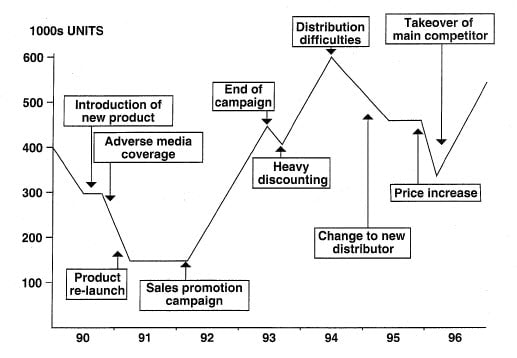


Homer Simpson: An economic analysis

Size Speed Significance

Trends and Changes
back to HOME > Learning English > Business English >
THE BLUE TREE
Business English

CEFR B2
Upper
Intermediate
warm up
Study this graph and then listen to and read the text that follows. Do you know what all the blue expressions mean?
The chart shows the US stock market (Dow Jones index) for last year and the first quarter of this year. As can be seen from the chart, last year started on a positive note. The market rose until late February when it almost reached the 11,000 level. But interest rates were rising, and investors decided to take profits. There was a sharp fall during the month of March and the Dow bottomed out at just over 10,000. At that point investors started buying again – strong economic numbers and global liquidity (central banks printing money) offered support to the market. Over the summer the Dow was flat, trading in a range from 10,300 to 10,700. The market was unable to break out of this range, even though company profits were increasing. What was the reason? It was almost entirely due to the price of oil, which had climbed dramatically from 42 dollars a barrel at the start of the year to 68 dollars in August. This price rise was caused by the hurricane season in the Gulf of Mexico and increasing tension in the Middle East.
In mid-October, the markets started to rally strongly and went from 10,200 to 10,900 over just four weeks. This sudden jump was as a result of comments made by a member of the Federal Reserve, who indicated that interest rates would soon stop rising. This is positive for business as the cost of borrowing also stops going up. From November to January the market remained more or less unchanged, failing to break through the February highs.
Over the last few months, the market has advanced again. The economic backdrop remains healthy: company profits are good, consumer spending is up, and interest rates are close to reaching a peak. The only dark cloud is the price of oil, which has risen back to the $70 level and looks certain to go up further. The next hurricane season is approaching and production worldwide cannot be significantly expanded.
STUDY SECTION
UPWARD MOVEMENT – PEAKS
Study the words and expressions that describe an upward movement or change.
Downward movement – troughs
Study the words and expressions for downward movement and changes.
Horizontal movement
How about words and expressions that describe no movement? Study these flashcards and make sure you know all of these expressions.
PRACTICE 1
Play this flashcard game. There are four categories:
➡️ upward,
➡️ downward,
➡️ horizontal,
and new one:
➡️ reason and cause.
Make note of all the new vocabulary.
PRACTICE 2

PRACTICE 3

Study these four graphs below and then do the activity that follows.

PRACTICE 4

Complete the joke by matching each noun or noun phrase on the left to a verb or verb phrase on the right.
And now do part 2 of the same activity.
SIZE SPEED SIGNIFICANCE
It is practical to qualify the trend with words or expressions from three categories:
- size
- speed
- significance
Study the mind map and learn the adjectives and adverbs for qualifying trends.

PRACTICE 5

Play this Multidecker game and decide if the words on the cards belong to the size, speed or significance category.
Finally, how would you complete the sentences below with these adjectives and adverbs for qualifying trends?
- In the last ten years there was a(n) ………………………… in my remuneration.
- Over the last decade my health has seen a(n) ………………………………
- Over the years, there has been a(n) ……………………………………… of my overall happiness.
- My country is experiencing a(n) …………………………. in prosperity.
- My overall outlook on life has seen a ……………………… over the years.
COMMENTING ON STATISTICS
When you are introducing trends, data or statistics in your presentations or reports, it is helpful to remember about three key steps:
1. HIGHLIGHT – draw your audience’s attention to your data
2. COMMENT – show your audience what this data mean to you
3. INTERPRET – explain the significance of these trends and statistics
Do the exercises below to learn some useful language for each of these steps.
You might need to comment on a trend by saying if it is good or bad news.
Practise some language of breaking good and bad news.








